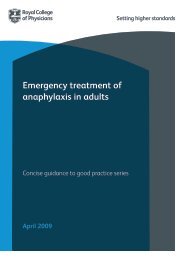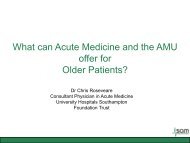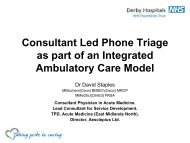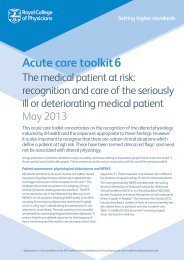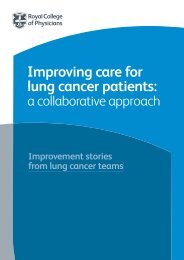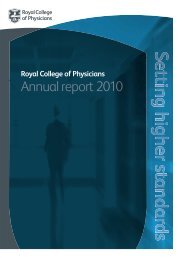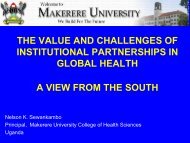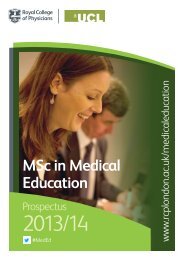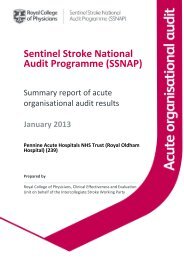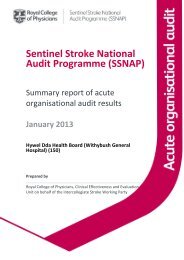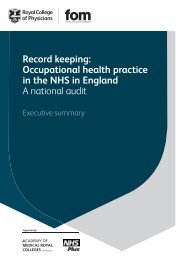Consultant physicians working with patients - Royal College of ...
Consultant physicians working with patients - Royal College of ...
Consultant physicians working with patients - Royal College of ...
Create successful ePaper yourself
Turn your PDF publications into a flip-book with our unique Google optimized e-Paper software.
3 Supporting the delivery <strong>of</strong> high-quality careclinical leads, the National Institute for Health and CareExcellence (NICE), the Healthcare QualityImprovement Partnership (HQIP), the Care QualityCommission (CQC), Health Improvement Scotland,the National Leadership and Innovation Agency forHealthcare in Wales, specialist societies, other royalcolleges and patient groups.Clinical management guidelinesTo provide optimal patient care it is necessary to knowwhat constitutes optimal care. Determining this can bedifficult, increasingly so as medicine becomes morecomplex, more treatments become available and theassociated scientific literature increases. One way <strong>of</strong>helping clinicians to manage their <strong>patients</strong> effectively inthe face <strong>of</strong> information overload is the production <strong>of</strong>clinical guidelines. The primary purpose <strong>of</strong> a guidelineis to set out recommendations for the most appropriatemanagement <strong>of</strong> <strong>patients</strong> <strong>with</strong> a specified condition.Therefore, guidelines should be as clear and direct aspossible. However, a patient <strong>with</strong> an uncomplicated,single pathology is something <strong>of</strong> a rarity. Concerns havebeen expressed that an over-reliance on guidelines willproduce doctors who cease to think through theirpractice and make decisions. This is no more anecessary consequence <strong>of</strong> relying on guidelines than <strong>of</strong>using textbooks or lectures for medical education.Recommendations must be applied to individual<strong>patients</strong> <strong>with</strong> their particular preferences and theirdifferent comorbidities. But it is still important to havea clear, basic foundation from which to build, andguidelines provide this.Guidelines should inform routine patient care andwhile it is reasonable to be at variance from standardguidance, as determined by a patient’s circumstances, itis prudent to document why the alternative course wastaken. This leads to the secondary function <strong>of</strong>guidelines – to provide a basis for the audit <strong>of</strong> thequality <strong>of</strong> patient care. Recommendations <strong>with</strong>inguidelines are an important source <strong>of</strong> audit criteria, andindeed many guidelines encourage this by suggestingappropriate topics.Producing guidelinesClinical guidelines are developed using a variety <strong>of</strong>methodologies. One <strong>of</strong> the most rigorous approaches isused by the National Clinical Guidelines Centre(www.ncgc.ac.uk).ThecentreishostedattheRCPtodeliver a large and diverse commissioned programmefor NICE. The guidelines have the advantage <strong>of</strong>incorporating both clinical and cost-effectivenessevidence. Another common methodology is the ScottishIntercollegiate Guidelines Network (SIGN) approach,which is <strong>of</strong>ten adopted by the specialist societies as it isless resource intensive and is consistent <strong>with</strong> theAppraisal <strong>of</strong> Guidelines Research and Evaluation(AGREE) collaboration (www.agreecollaboration.org),an international collaboration quality assuringguideline methodology. This methodology is also usedfor the development <strong>of</strong> guidelines for occupationalhealth, stroke and in the Concise Guidelines to GoodPractice series.The topics that RCP guidelines cover grow on amonthly basis and can be found on the RCP website(www.rcplondon.ac.uk/resources/clinical-resources).Specialist societies produce excellent guidelines whichare particularly useful sources <strong>of</strong> information on rarertopics that are less likely to be covered by NICE. TheRCP is supporting specialist society guidelines bypublishing the Concise Guidelines series in ClinicalMedicine and in booklet form.National comparative clinical auditDonabedian defined quality <strong>of</strong> care as ‘the degree <strong>of</strong>conformance to, or deviation from, normativebehavior’. 2 Brook and Kosec<strong>of</strong>f more succinctly definedit as ‘doing the right things . . . well’. 3 In 2010, followinga review <strong>of</strong> the literature and a consultation exercise, theRCP developed its own definition <strong>of</strong> quality. Itcomprises seven domains: safety, <strong>patients</strong>’ experience,effectiveness, equity, efficiency, timeliness andsustainability. All definitions imply the need forstandards – ‘normative behaviour’ and ‘doing the rightthings’ – and the need for measurement <strong>of</strong> practice, allkey elements <strong>of</strong> clinical audit.Clinical audit is conventionally considered as a cycle <strong>of</strong>quality improvement that involves measurement <strong>of</strong> theeffectiveness <strong>of</strong> healthcare against agreed and provenstandards for high quality, and taking action to bringpractice in line <strong>with</strong> these standards so as toimprove the quality <strong>of</strong> care and health outcomes.Detailed advice for carrying out clinical audit can befound in New principles <strong>of</strong> best practice in clinical audit 4and Local clinical audit: handbook for <strong>physicians</strong> (HQIP,2010). 5Recommendations include the following:Determining standards for practice: increasinglystandards are based on evidence or derived from soundC○ <strong>Royal</strong> <strong>College</strong> <strong>of</strong> Physicians 2013 267



